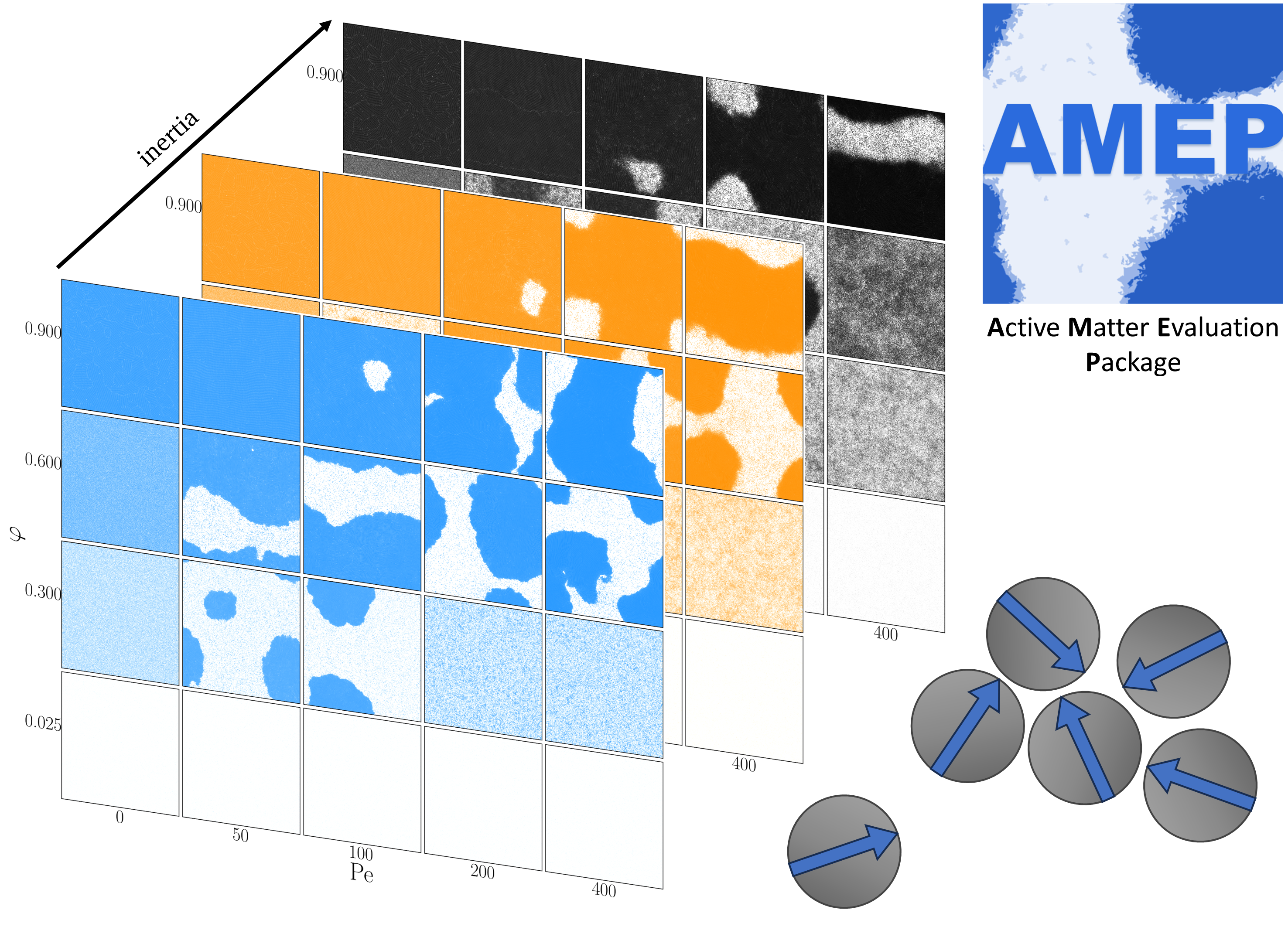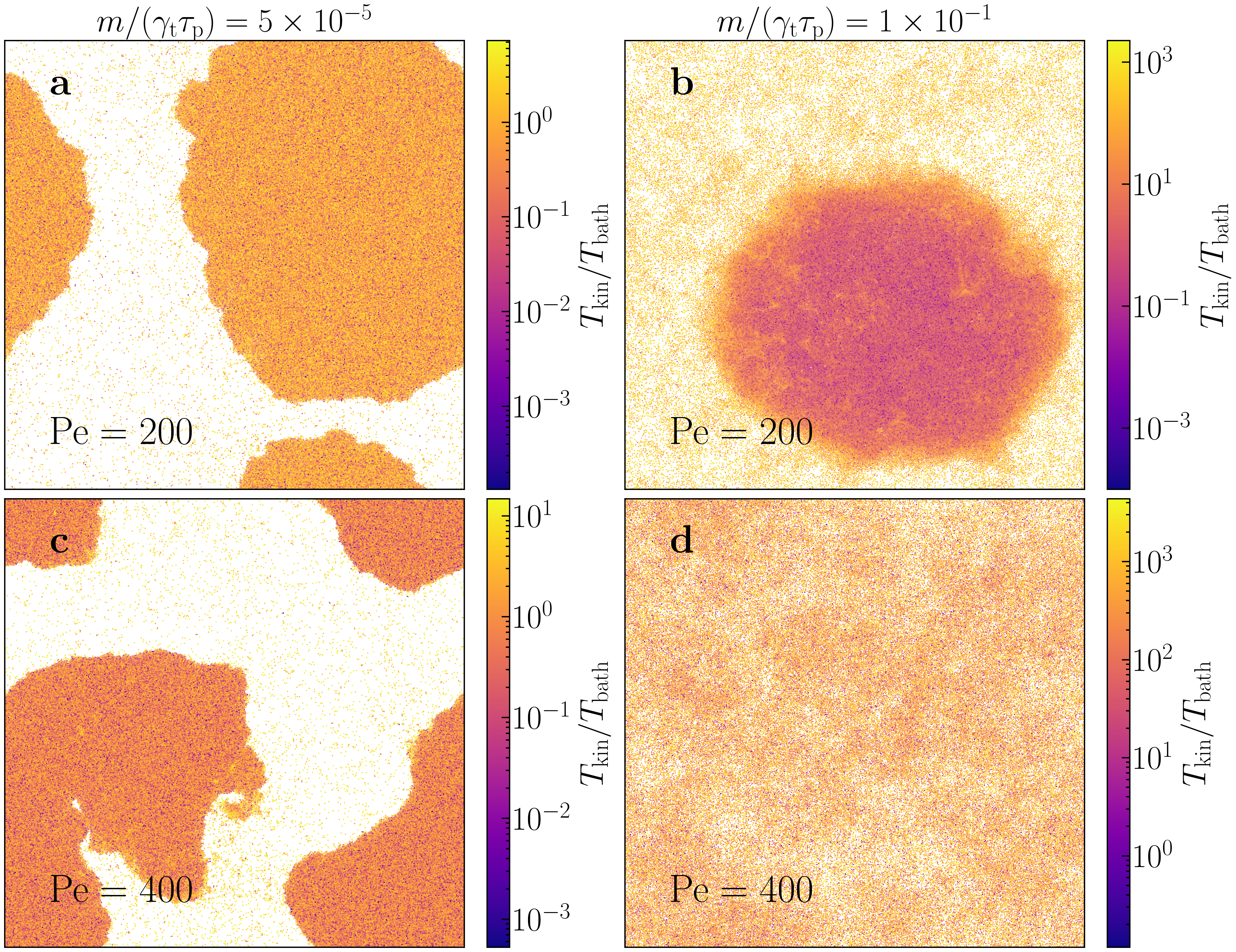Project
Phase Diagram of Inertial Active Brownian Particles
Active matter consisting of motile agents such as bacteria, algae, or synthetic microswimmers on the microscale and fishes, birds, or drones on the macroscale show a multitude of collective phenomena such as flocking, pattern formation, and phase separation for example. Such phenomena are frequently studied using minimal models such as the active Brownian particle model in which each agent is modeled as a spherical particle interacting with its neighboring particles and self-propelling into a direction that changes randomly over time due to thermal fluctuations. While this model has extensively been studied in the overdamped regime, in which the mass of the agents can be neglected as for motile agents on the microscale, inertia is known to induce remarkable non-equilibrium phenomena such as the coexistence of a gas-like and a liquid-like phase with different kinetic temperatures. To understand the effects of inertia on collective phenomena in active matter in more detail, an extensive exploration of the parameter space corresponding to the active Brownian particle model is required. This would allow to create a phase diagram from which we can learn which phases exist, how they can be characterized, and how they are influenced by inertia. This study requires not only a huge number of numerical simulations to scan the parameter space but also an efficient framework for the data analysis. To this end, we used the granted computational resources of Lichtenberg II to create a phase diagram of inertial active Brownian particles using Brownian dynamics simulations and to develop a Python library for analyzing large-scale simulation data of active matter models.
Project Details
Project term
October 1, 2022–December 31, 2023
Affiliations
TU Darmstadt
Institute
Institute for Condensed Matter Physics
Project Manager
Principal Investigator
Methods
We used Brownian dynamics simulations to numerically solve the Langevin equations of the active Brownian particle model in a two-dimensional simulation box with periodic boundary conditions. All simulations have been performed using the Large-scale Atomic/Molecular Massively Parallel Simulator (LAMMPS) with 105–106 particles for up to 109 time steps. The simulations allowed us to investigate the active Brownian particle model from the low-density, gas-like regime to the high-density, crystal-like regime for different self-propulsion speeds and different inertia to create a three-dimensional phase diagram. To analyze the simulation data, we developed in-house Python code and used the computational resources for improving and optimizing the code especially for the use on high-performance computing hardware.
Results
The granted computational resources allowed us to scan a large parameter regime by varying the mass of the particles (inertia), the particle number density, and the activity of the particles (self-propulsion speed). We identified different states of the system ranging from liquid and gas-like phases to phase-separated states at intermediate activity and crystal-like structures at very high particle number density. We found that inertia has important effects on the transition lines between these different phases and that inertia can be used to introduce different kinetic temperatures in coexisting phases such as dense clusters and a surrounding gas-like phase even in mixtures of active and passive Brownian particles. Additionally, we developed the Active Matter Evaluation Package (AMEP), which is a powerful Python library for analyzing large-scale particle-based and continuum simulations of active matter models.
Discussion
The study of the phase diagram of inertial active Brownian particles is crucial for the understanding of the effects of inertia on the properties of active matter systems. For example, inertia can be used to tune the transition of an active system from one state to another. Remarkably, we found that inertia can lead to the coexistence of different kinetic temperatures even in mixtures of active and passive Brownian particles which opens a route for new and promising experiments. As a next step, we plan to perform a finite-size scaling analysis to identify the transition lines between the different states in more detail. Finally, this project helped to develop the AMEP Python library, which provides a unified framework for analyzing simulation data of active matter models.
Additional Project Information
DFG classification: 307-02 Theoretical Condensed Matter Physics
Software: LAMMPS
Cluster: Lichtenberg
 Figure 1: Non-equilibrium phase diagram of inertial active Brownian particles analyzed using the active matter evaluation package (AMEP).
Figure 1: Non-equilibrium phase diagram of inertial active Brownian particles analyzed using the active matter evaluation package (AMEP).  Figure 2: Motility-induced phase separation (MIPS) and kinetic temperature differences in coexisting phases at area fraction φ = 0.6. The particles are colored with respect to their kinetic temperature. (a,c) MIPS of overdamped active Brownian particles (ABPs) at Pe=200 and Pe=400, respectively. (b) MIPS of inertial ABPs at Pe=200 showing different kinetic temperatures in the dense and the dilute phase. (d) Inertia precludes MIPS at high activity (Pe=400).
Figure 2: Motility-induced phase separation (MIPS) and kinetic temperature differences in coexisting phases at area fraction φ = 0.6. The particles are colored with respect to their kinetic temperature. (a,c) MIPS of overdamped active Brownian particles (ABPs) at Pe=200 and Pe=400, respectively. (b) MIPS of inertial ABPs at Pe=200 showing different kinetic temperatures in the dense and the dilute phase. (d) Inertia precludes MIPS at high activity (Pe=400).